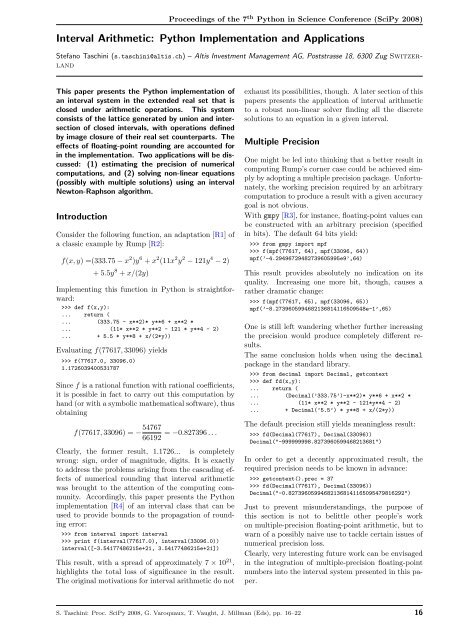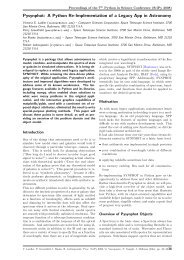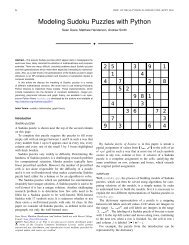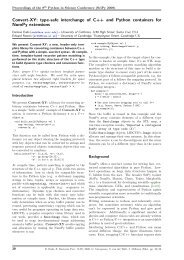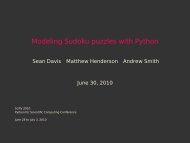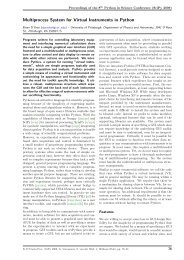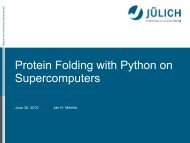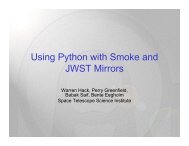Interval Arithmetic: Python Implementation and Applications - SciPy ...
Interval Arithmetic: Python Implementation and Applications - SciPy ...
Interval Arithmetic: Python Implementation and Applications - SciPy ...
Create successful ePaper yourself
Turn your PDF publications into a flip-book with our unique Google optimized e-Paper software.
Proceedings of the 7 th <strong>Python</strong> in Science Conference (<strong>SciPy</strong> 2008)<br />
<strong>Interval</strong> <strong>Arithmetic</strong>: <strong>Python</strong> <strong>Implementation</strong> <strong>and</strong> <strong>Applications</strong><br />
Stefano Taschini (s.taschini@altis.ch) – Altis Investment Management AG, Poststrasse 18, 6300 Zug Switzerl<strong>and</strong><br />
This paper presents the <strong>Python</strong> implementation of<br />
an interval system in the extended real set that is<br />
closed under arithmetic operations. This system<br />
consists of the lattice generated by union <strong>and</strong> intersection<br />
of closed intervals, with operations defined<br />
by image closure of their real set counterparts. The<br />
effects of floating-point rounding are accounted for<br />
in the implementation. Two applications will be discussed:<br />
(1) estimating the precision of numerical<br />
computations, <strong>and</strong> (2) solving non-linear equations<br />
(possibly with multiple solutions) using an interval<br />
Newton-Raphson algorithm.<br />
Introduction<br />
Consider the following function, an adaptation [R1] of<br />
a classic example by Rump [R2]:<br />
f(x, y) =(333.75 − x 2 )y 6 + x 2 (11x 2 y 2 − 121y 4 − 2)<br />
+ 5.5y 8 + x/(2y)<br />
Implementing this function in <strong>Python</strong> is straightforward:<br />
>>> def f(x,y):<br />
... return (<br />
... (333.75 - x**2)* y**6 + x**2 *<br />
... (11* x**2 * y**2 - 121 * y**4 - 2)<br />
... + 5.5 * y**8 + x/(2*y))<br />
Evaluating f(77617, 33096) yields<br />
>>> f(77617.0, 33096.0)<br />
1.1726039400531787<br />
Since f is a rational function with rational coefficients,<br />
it is possible in fact to carry out this computation by<br />
h<strong>and</strong> (or with a symbolic mathematical software), thus<br />
obtaining<br />
f(77617, 33096) = − 54767<br />
66192 = −0.827396 . . .<br />
Clearly, the former result, 1.1726... is completely<br />
wrong: sign, order of magnitude, digits. It is exactly<br />
to address the problems arising from the cascading effects<br />
of numerical rounding that interval arithmetic<br />
was brought to the attention of the computing community.<br />
Accordingly, this paper presents the <strong>Python</strong><br />
implementation [R4] of an interval class that can be<br />
used to provide bounds to the propagation of rounding<br />
error:<br />
>>> from interval import interval<br />
>>> print f(interval(77617.0), interval(33096.0))<br />
interval([-3.54177486215e+21, 3.54177486215e+21])<br />
This result, with a spread of approximately 7 × 10 21 ,<br />
highlights the total loss of significance in the result.<br />
The original motivations for interval arithmetic do not<br />
exhaust its possibilities, though. A later section of this<br />
papers presents the application of interval arithmetic<br />
to a robust non-linear solver finding all the discrete<br />
solutions to an equation in a given interval.<br />
Multiple Precision<br />
One might be led into thinking that a better result in<br />
computing Rump’s corner case could be achieved simply<br />
by adopting a multiple precision package. Unfortunately,<br />
the working precision required by an arbitrary<br />
computation to produce a result with a given accuracy<br />
goal is not obvious.<br />
With gmpy [R3], for instance, floating-point values can<br />
be constructed with an arbitrary precision (specified<br />
in bits). The default 64 bits yield:<br />
>>> from gmpy import mpf<br />
>>> f(mpf(77617, 64), mpf(33096, 64))<br />
mpf(’-4.29496729482739605995e9’,64)<br />
This result provides absolutely no indication on its<br />
quality. Increasing one more bit, though, causes a<br />
rather dramatic change:<br />
>>> f(mpf(77617, 65), mpf(33096, 65))<br />
mpf(’-8.2739605994682136814116509548e-1’,65)<br />
One is still left w<strong>and</strong>ering whether further increasing<br />
the precision would produce completely different results.<br />
The same conclusion holds when using the decimal<br />
package in the st<strong>and</strong>ard library.<br />
>>> from decimal import Decimal, getcontext<br />
>>> def fd(x,y):<br />
... return (<br />
... (Decimal(’333.75’)-x**2)* y**6 + x**2 *<br />
... (11* x**2 * y**2 - 121*y**4 - 2)<br />
... + Decimal(’5.5’) * y**8 + x/(2*y))<br />
The default precision still yields meaningless result:<br />
>>> fd(Decimal(77617), Decimal(33096))<br />
Decimal("-999999998.8273960599468213681")<br />
In order to get a decently approximated result, the<br />
required precision needs to be known in advance:<br />
>>> getcontext().prec = 37<br />
>>> fd(Decimal(77617), Decimal(33096))<br />
Decimal("-0.827396059946821368141165095479816292")<br />
Just to prevent misunderst<strong>and</strong>ings, the purpose of<br />
this section is not to belittle other people’s work<br />
on multiple-precision floating-point arithmetic, but to<br />
warn of a possibly naive use to tackle certain issues of<br />
numerical precision loss.<br />
Clearly, very interesting future work can be envisaged<br />
in the integration of multiple-precision floating-point<br />
numbers into the interval system presented in this paper.<br />
S. Taschini: Proc. <strong>SciPy</strong> 2008, G. Varoquaux, T. Vaught, J. Millman (Eds), pp. 16–22 16
Proceedings of the 7 th <strong>Python</strong> in Science Conference (<strong>SciPy</strong> 2008)<br />
Functions of intervals<br />
Notation-wise, the set of all closed intervals with endpoints<br />
in a set X is denoted as<br />
IX = {[a, b] | a, b ∈ X}<br />
The symbols R <strong>and</strong> R ∗ denote the set of the real<br />
numbers <strong>and</strong> the extended set of real numbers, R ∗ =<br />
R ∪ {−∞, +∞}. Let f([a, b]) be the image of the<br />
closed interval [a, b] under the function f. Real analysis<br />
teaches that if the interval is bounded <strong>and</strong> the<br />
function is continuous over the interval, then f([a, b])<br />
is also a closed, bounded interval, <strong>and</strong>, more significantly,<br />
[<br />
]<br />
f([a, b]) = min f(x), max f(x) (1)<br />
x∈[a,b] x∈[a,b]<br />
Computing the minimum <strong>and</strong> maximum is trivial if<br />
the function is monotonic (see Figure 1), <strong>and</strong> also for<br />
the non-monotonic st<strong>and</strong>ard mathematical functions<br />
(even-exponent power, cosh, sin, cos...) these are relatively<br />
easy to determine.<br />
f(b)<br />
f(a)<br />
y<br />
a<br />
b<br />
x<br />
f(a)<br />
f(b)<br />
Figure 1. The image f([a, b]) for a continuous monotonic function:<br />
[f(a), f(b)] for a non-decreasing f (left), <strong>and</strong> [f(b), f(a)]<br />
for a non-increasing f (right).<br />
Equation (1) no longer holds if the interval is unbounded<br />
– e.g., tanh([0, +∞]) = [0, 1), which is not<br />
closed on the right – or the function is not continuous<br />
over the whole interval – e.g., the inverse function<br />
inv(x) = 1/x yields inv([−1, +1]) = (−∞, −1] ∪<br />
[+1, +∞), two disjoint intervals (see Figure 2).<br />
a<br />
f(b)<br />
y<br />
f(a)<br />
Figure 2. The image f([a, b]), with f(x) = 1/x, is the union<br />
of two disjoint intervals.<br />
Both limitations can be overcome by means of two generalizations:<br />
1) using the image closure instead of the<br />
image, <strong>and</strong> 2) looking at the lattice generated by IR ⋆<br />
instead of IR ⋆ .<br />
y<br />
b<br />
a<br />
b<br />
x<br />
x<br />
The image closure is defined for any subset K ⊆ R ∗ as<br />
{<br />
}<br />
¯f(K) = lim f(x n) ∣ lim x n ∈ K (2)<br />
n→∞ n→∞<br />
Equation (2) is a generalization of equation (1), in the<br />
sense that if f is continuous over K <strong>and</strong> K is a closed,<br />
bounded interval, equations (1) <strong>and</strong> (2) yield the same<br />
result, i.e.:<br />
f ∈ C 0 ([a, b]) =⇒ ¯f([a, b]) = f([a, b])<br />
The lattice generated by the intervals in the extended<br />
real set, L(IR ∗ ), is the smallest family of sets containing<br />
IR ∗ that is closed under union <strong>and</strong> intersection –<br />
this extension accommodates the fact that, in general,<br />
the union of two intervals is not an interval. The sets<br />
in the lattice can always be written as the finite union<br />
of closed intervals in R ∗ . In <strong>Python</strong>,<br />
>>> k = interval([0, 1], [2, 3], [10, 15])<br />
represents the the union [0, 1]∪[2, 3]∪[10, 15] ∈ L(IR ∗ ).<br />
The intervals [0, 1], [2, 3], <strong>and</strong> [10, 15] constitute the<br />
connected components of k. If the lattice element consists<br />
of only one component it can be written, e.g., as<br />
>>> interval[1, 2]<br />
interval([1.0, 2.0])<br />
signifying the interval [1, 2], not to be confused with<br />
>>> interval(1, 2)<br />
interval([1.0], [2.0])<br />
which denotes {1} ∪ {2}. When referring to a lattice<br />
element consisting of one degenerate interval, say {1},<br />
both following short forms yield the same object:<br />
>>> interval(1), interval[1]<br />
(interval([1.0]), interval([1.0]))<br />
The empty set is represented by an interval with no<br />
components:<br />
>>> interval()<br />
interval()<br />
The state of the art on interval arithmetic [R5] is at<br />
present limited to considering either intervals of the<br />
form [a, b] with a, b ∈ R ∗ or to pairs [−∞, a] ∪ [b, ∞],<br />
as in the Kahan-Novoa-Ritz arithmetic [R6]. The more<br />
general idea of taking into consideration the lattice<br />
generated by the closed intervals is, as far as the author<br />
knows, original.<br />
Note that equation (2) provides a consistent definition<br />
for evaluating a function at plus or minus infinity:<br />
{<br />
}<br />
¯f({+∞}) = lim f(x n) ∣ lim x n = +∞<br />
n→∞ n→∞<br />
{<br />
}<br />
¯f({−∞}) = lim f(x n) ∣ lim x n = −∞<br />
n→∞ n→∞<br />
For instance, in the case of the hyperbolic tangent one<br />
has that tanh({+∞}) = {1}. More generally, it can<br />
be proved that if f is discontinuous at most at a finite<br />
set of points, then<br />
∀K ∈ L(IR ∗ ), ¯f(K) ∈ L(IR ∗ ) (3)<br />
17 http://conference.scipy.org/proceedings/<strong>SciPy</strong>2008/paper_3
<strong>Interval</strong> <strong>Arithmetic</strong>: <strong>Python</strong> <strong>Implementation</strong> <strong>and</strong> <strong>Applications</strong><br />
The expression in equation (3) can be computed by<br />
expressing K as a finite union of intervals, <strong>and</strong> then<br />
by means of the identity<br />
¯f ( ⋃ h [a h, b h ]) = ⋃ h ¯f([a h , b h ])<br />
For the inverse function, one has that<br />
with<br />
inv ( ⋃ h [a h, b h ]) = ⋃ h inv([a h, b h ])<br />
inv([a, b]) =<br />
⎧<br />
⎨<br />
[b −1 , a −1 ] if 0 ∉ [a, b]<br />
⎩[−∞, inv − (a)] ∪ [inv + (b), +∞] if 0 ∈ [a, b]<br />
where inv − (0) = −∞, inv + (0) = +∞, <strong>and</strong> inv − (x) =<br />
inv + (x) = 1/x if x ≠ 0.<br />
In <strong>Python</strong>,:<br />
>>> interval[0].inverse()<br />
interval([-inf], [inf])<br />
>>> interval[-2,+4].inverse()<br />
interval([-inf, -0.5], [0.25, inf])<br />
<strong>Interval</strong> arithmetic<br />
The definition of image closure can be immediately extended<br />
to a function of two variables. This allows sum<br />
<strong>and</strong> multiplication in L(IR ∗ ) to be defined as<br />
{<br />
}<br />
H + K = lim (x n + y n ) ∣ lim x n ∈ H, lim y n ∈ K<br />
n→∞ n→∞ n→∞<br />
{<br />
H × K =<br />
∣ ∣∣<br />
lim x ny n lim x n ∈ H, lim y n ∈ K<br />
n→∞ n→∞ n→∞<br />
Since sum <strong>and</strong> multiplication are continuous in R × R<br />
the limits need to be calculated only when at least one<br />
of the end-points is infinite. Otherwise the two operations<br />
can be computed component-by-component using<br />
equation (1). Subtraction <strong>and</strong> division are defined<br />
as<br />
H − K = H + {−1} × K<br />
H ÷ K = H × inv(K)<br />
These definitions provide a consistent generalization of<br />
the real-set arithmetic, in the sense that for any real<br />
numbers x <strong>and</strong> y<br />
x ∈ H, y ∈ K =⇒ x ⋄ y ∈ H ⋄ K<br />
whenever x⋄y is defined, with ⋄ representing one of the<br />
arithmetic operations. Additionally, this arithmetic is<br />
well-defined for infinite end-points <strong>and</strong> when dividing<br />
for intervals containing zero.<br />
In conclusion, the lattice of intervals in the real extended<br />
set is closed under the arithmetic operations as<br />
defined by image closure of their real counterparts.<br />
In <strong>Python</strong>, the arithmetic operations are input using<br />
the usual +, -, * <strong>and</strong> / operators, with integerexponent<br />
power denoted by the ** operator. Additionally,<br />
intersection <strong>and</strong> union are denoted using the<br />
& <strong>and</strong> | operators, respectively.<br />
}<br />
Dependency<br />
One may not always want to find the image closure of<br />
a given function on a given interval. Even for a simple<br />
function like f(x) = x 2 −x one might wish to compute<br />
f([0, 2]) by interpreting the expression x 2 − x using<br />
interval arithmetic. Interestingly, whereas<br />
∀x ∈ R, x 2 − x = x(x − 1) = (x − 1/2) 2 − 1/4<br />
the three expressions lead to different results when applied<br />
to intervals:<br />
>>> (lambda x: x**2 - x)(interval[0,2])<br />
interval([-2.0, 4.0])<br />
>>> (lambda x: x*(x - 1))(interval[0,2])<br />
interval([-2.0, 2.0])<br />
>>> (lambda x: (x - 0.5)**2 - 0.25)(interval[0,2])<br />
interval([-0.25, 2.0])<br />
Incidentally, graphic inspection (see Figure 3) immediately<br />
reveals that ¯f([0, 2]) = [−1/4, 2]. The three<br />
interval functions<br />
f 1 : X ∈ L(IR ∗ ) ↦→ X 2 − X<br />
f 2 : X ∈ L(IR ∗ ) ↦→ X(X − 1)<br />
f 3 : X ∈ L(IR ∗ ) ↦→ (X − 1/2) 2 − 1/4<br />
(4)<br />
differ because interval arithmetic h<strong>and</strong>les reoccurrences<br />
of the same variables as independent instances<br />
of the same interval. Only in the case of f 3 , where X<br />
occurs only once, one has that f 3 (X) = ¯f(X). For the<br />
other two cases, given,<br />
g 1 : (x, y) ∈ R × R ↦→ x 2 − y<br />
g 2 : (x, y) ∈ R × R ↦→ x(y − 1)<br />
one has that f 1 (X) = ḡ 1 (X, X) <strong>and</strong> f 2 (X) = ḡ 2 (X, X).<br />
This phenomenon, called dependency, causes f 2 <strong>and</strong><br />
f 3 to yield in general wider intervals (or the union<br />
thereof) than what is returned by the image closure.<br />
2<br />
−1/4<br />
y<br />
0 2<br />
Figure 3. f([0, 2]) for f(x) = x 2 − x.<br />
The idea of a function g on the interval lattice returning<br />
“wider” results than needed is captured by saying<br />
that g is an interval extension of f:<br />
g ∈ ext(f) ⇐⇒ ∀X ∈ L(IR ∗ ), ¯f(X) ⊆ g(X)<br />
Referring to the example of equation (4), f 1 , f 2 , <strong>and</strong><br />
f 3 are all interval extensions of f. <strong>Interval</strong> extensions<br />
x<br />
http://conference.scipy.org/proceedings/<strong>SciPy</strong>2008/paper_3 18
Proceedings of the 7 th <strong>Python</strong> in Science Conference (<strong>SciPy</strong> 2008)<br />
can be partially ordered by their sharpness: given<br />
two extensions g, h ∈ ext(f), g is sharper than h on<br />
X ∈ L(IR ∗ ) if g(X) ⊂ h(X).<br />
The extensions f 1 , f 2 are not as sharp as f 3 because<br />
of dependency. A second source of sharpness loss is<br />
rounding, as it will be shown in the following.<br />
Reals <strong>and</strong> floats<br />
Floating-point numbers, or floats in short, form a finite<br />
subset F ⊂ R ∗ . It is assumed that floats are defined<br />
according to the IEEE 754 st<strong>and</strong>ard [R7]. Rounding is<br />
the process of approximating an arbitrary real number<br />
with some float. It is worth noting that rounding is a<br />
necessity because for an arbitrary real function f <strong>and</strong><br />
an arbitrary float x ∈ F, f(x) is generally not a float.<br />
Of the four rounding techniques defined in the st<strong>and</strong>ard,<br />
relevant for the following are rounding toward<br />
−∞, or down, defined as<br />
↓(x) = max{p ∈ F | p ≤ x}<br />
<strong>and</strong> rounding towards +∞, or up, defined as<br />
↑(x) = min{p ∈ F | p ≥ x}<br />
The interval I(x) = [↓(x), ↑(x)] is the float enclosure<br />
of x, i.e., the smallest interval containing x with<br />
end-points in F. The enclosure degenerates to the<br />
single-element set {x} whenever x ∈ F. Similarly,<br />
for an interval [a, b], its float enclosure is given by<br />
I([a, b]) = [↓(a), ↑(b)]. Note that the enclousure of<br />
an interval extension f is also an interval extension, at<br />
best as sharp as f.<br />
Also for any of the arithmetic operations, again represented<br />
by ⋄, it can happen that for any two arbitrary<br />
H, K ∈ L(IF), H ⋄ K ∉ L(IF). It is therefore necessary<br />
to use the float enclosure of the interval arithmetic<br />
operations:<br />
H ⊕ K = I(H + K) H ⊖ K = I(H − K)<br />
H ⊗ K = I(H × K) H ⊘ K = I(H ÷ K)<br />
In <strong>Python</strong>, the effect of the float enclosure on the arithmetic<br />
operations is easily verifiable:<br />
>>> interval[10] / interval[3]<br />
interval([3.333333333333333, 3.3333333333333339])<br />
Controlling the rounding mode of the processor’s<br />
floating-point unit ensures that arithmetic operations<br />
are rounded up or down. In the <strong>Python</strong> implementation<br />
presented here, ctypes provides the low-level<br />
way to access the st<strong>and</strong>ard C99 functions as declared<br />
in fenv.h [R8], falling back to the Microsoft C runtime<br />
equivalents if the former are not present. A lambda expression<br />
emulates the lazy evaluation that is required<br />
by the primitives in the interval.fpu module:<br />
>>> from interval import fpu<br />
>>> fpu.down(lambda: 1.0/3.0)<br />
0.33333333333333331<br />
>>> fpu.up(lambda: 1.0/3.0)<br />
0.33333333333333337<br />
Unfortunately, common implementations of the C<br />
st<strong>and</strong>ard mathematical library do not provide the<br />
means of controlling how transcendental functions are<br />
rounded. For this work it was thus decided to use CRlibm,<br />
the Correctly Rounded Mathematical Library<br />
[R9], which makes it possible to implement the float<br />
enclosure of the image closures for the most common<br />
transcendental functions.<br />
The transcendental functions are packaged in the<br />
interval.imath module:<br />
>>> from interval import imath<br />
>>> imath.exp(1)<br />
interval([2.7182818284590451, 2.7182818284590455])<br />
>>> imath.log(interval[-1, 1])<br />
interval([-inf, 0.0])<br />
>>> imath.tanpi(interval[0.25, 0.75])<br />
interval([-inf, -1.0], [1.0, inf])<br />
A more compact output for displaying intervals is provided<br />
by the to_s() method, whereby a string is returned<br />
that highlights the common prefix in the decimal<br />
expansion of the interval’s endpoints. For instance,<br />
some of the examples above can be better displayed<br />
as:<br />
>>> (1 / interval[3]).to_s()<br />
’0.3333333333333333(1,7)’<br />
>>> imath.exp(1).to_s()<br />
’2.718281828459045(1,5)’<br />
Solving nonlinear equations<br />
Let f be a smooth function in [a, b], i.e., therein continuous<br />
<strong>and</strong> differentiable. Using the mean-value theorem<br />
it can be proved that if x ∗ ∈ [a, b] is a zero of f, then<br />
∀ξ ∈ [a, b],<br />
x ∗ ∈ ¯N({ξ}, [a, b])<br />
where N is the Newton iteration function,<br />
N(ξ, η) = ξ − f(ξ)/f ′ (η) (5)<br />
If f(x) = 0 has more than one solutions inside [a, b],<br />
then, by Rolle’s theorem, the derivative must vanish<br />
somewhere in [a, b]. This in turn nullifies the denominator<br />
in equation (5), which causes ¯N({ξ}, [a, b]) to<br />
possibly return two disjoint intervals, in each of which<br />
the search can continue. The complete algorithm is<br />
implemented in <strong>Python</strong> as a method of the interval<br />
class:<br />
19 http://conference.scipy.org/proceedings/<strong>SciPy</strong>2008/paper_3
<strong>Interval</strong> <strong>Arithmetic</strong>: <strong>Python</strong> <strong>Implementation</strong> <strong>and</strong> <strong>Applications</strong><br />
def newton(self, f, p, maxiter=10000):<br />
def step(x, i):<br />
return (x - f(x) / p(i)) & i<br />
def some(i):<br />
yield i.midpoint<br />
for x in i.extrema.components:<br />
yield x<br />
def branch(current):<br />
for n in xrange(maxiter):<br />
previous = current<br />
for anchor in some(current):<br />
current = step(anchor, current)<br />
if current != previous:<br />
break<br />
else:<br />
return current<br />
if not current:<br />
return current<br />
if len(current) > 1:<br />
return self.union(branch(c) for<br />
c in current.components)<br />
return current<br />
return self.union(branch(c) for<br />
c in self.components)<br />
y<br />
x<br />
In this code, step implements an interval extension<br />
of equation (4), with the additional intersection with<br />
the current interval to make sure that iterations are<br />
not widening the interval. Function some selects ξ:<br />
first the midpoint is tried, followed by each of the endpoints.<br />
The arguments f <strong>and</strong> p represent the function<br />
to be nullified <strong>and</strong> its derivative. The usage of<br />
the Newton-Raphson solver is straightforward. For instance,<br />
the statement required to find the solutions to<br />
the equation<br />
(x 2 − 1)(x − 2) = 0 x ∈ [−100, +100]<br />
0···<br />
4···<br />
8·· ̌<br />
·<br />
12 ∅<br />
·<br />
·<br />
·<br />
16···<br />
simply is<br />
>>> interval[-100, 100].newton(<br />
... lambda x: (x**2 - 1)*(x - 2),<br />
... lambda x: 3*x**2 - 4*x -1)<br />
interval([-1.0], [1.0], [2.0])<br />
Figure 4 shows the iterations needed to solve the same<br />
equation in the smaller interval [−1.5, 3]. The nonlinear<br />
solver can be used with non-algebraic equations<br />
as well:<br />
>>> interval[-100, 100].newton(<br />
... lambda x: imath.exp(x) + x,<br />
... lambda x: imath.exp(x) + 1).to_s()<br />
’-0.567143290409783(95,84)’<br />
solves the equation<br />
<strong>and</strong>:<br />
e x + x = 0 x ∈ [−100, +100]<br />
>>> print interval[-10, 10].newton(<br />
... lambda x: imath.cospi(x/3) - 0.5,<br />
... lambda x: -imath.pi * imath.sinpi(x/3) / 3)<br />
interval([-7.0, -7.0], [-5.0, -5.0], [-1.0, -1.0],<br />
[1.0, 1.0], [5.0, 5.0], [7.0, 7.0])<br />
solves the equation<br />
cos<br />
( πx<br />
)<br />
= 1 3 2<br />
x ∈ [−10, +10]<br />
20···<br />
24 ̌<br />
·<br />
· ∅<br />
·<br />
28· ∅<br />
·<br />
·<br />
32···<br />
36· ̌<br />
Figure 4. Solving (x 2 − 1)(x − 2) = 0 in [−100, +100]. An iteration<br />
producing an empty interval is marked as ∅, whereas<br />
the checkmark denotes an iteration producing a fixed-point.<br />
References<br />
[R1] E. Loh, G. W. Walster, “Rump’s example revisited”,<br />
Reliable Computing, vol. 8 (2002), n. 2, pp. 245–248.<br />
[R2] S. M. Rump, “Algorithm for verified inclusionstheory<br />
<strong>and</strong> practice”, Reliability in Computing, Academic<br />
Press, (1988), pp. 109–126.<br />
http://conference.scipy.org/proceedings/<strong>SciPy</strong>2008/paper_3 20
Proceedings of the 7 th <strong>Python</strong> in Science Conference (<strong>SciPy</strong> 2008)<br />
[R3] A. Martelli (maintainer), “Gmpy, multiprecision<br />
arithmetic for <strong>Python</strong>”, http://gmpy.googlecode.<br />
com/.<br />
[R4] S. Taschini, “Pyinterval, interval arithmetic<br />
in <strong>Python</strong>”, http://pypi.python.org/pypi/<br />
pyinterval.<br />
[R5] E. Hansen, G. W. Walster, Global Optimization Using<br />
<strong>Interval</strong> Analysis, 2nd edition, John Dekker Inc.<br />
(2003).<br />
[R6] R. Baker Kearfott, Rigorous Global Search: Continuous<br />
Problems, Kluwer (1996).<br />
[R7] D. Goldberg, “What every computer scientist should<br />
know about floating-point arithmetic”, ACM Computing<br />
Surveys, vol. 23 (1991), pp. 5–48.<br />
[R8] http://www.opengroup.org/onlinepubs/009695399/<br />
basedefs/fenv.h.html.<br />
[R9] J. M. Muller, F. de Dinechin (maintainers), “CRlibm,<br />
an efficient <strong>and</strong> proven correctly-rounded mathematical<br />
library”, http://lipforge.ens-lyon.fr/<br />
www/crlibm/.<br />
21 http://conference.scipy.org/proceedings/<strong>SciPy</strong>2008/paper_3


